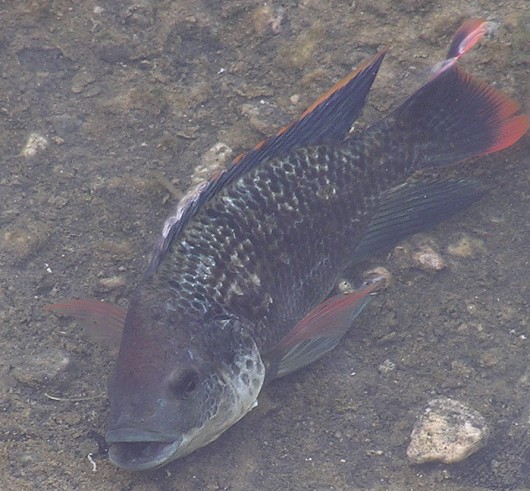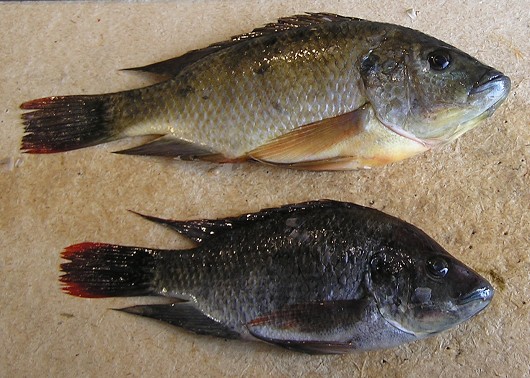Mozambique Tilapia
-
Scientific NameOreochromis mossambicus
-
NativeNon-Native
-
Identification
 Mozambique tilapia hybrid, male, observed in the Salton Sea on 10/05/06. Photo by Sharon Keeney, California Department of Fish and Game. Note: this is a California Mozambique tilapia hybrid (Oreochromis mossambicus x O. urolepis hornorum).
Mozambique tilapia hybrid, male, observed in the Salton Sea on 10/05/06. Photo by Sharon Keeney, California Department of Fish and Game. Note: this is a California Mozambique tilapia hybrid (Oreochromis mossambicus x O. urolepis hornorum). Mozambique tilapia hybrid, female (top) and male (bottom), captured from the Salton Sea in 2006. Photo by Sharon Keeney, California Department of Fish and Game. Note: these are tilapia hybrids (O. mossambicus x O. urolepis hornorum).
Mozambique tilapia hybrid, female (top) and male (bottom), captured from the Salton Sea in 2006. Photo by Sharon Keeney, California Department of Fish and Game. Note: these are tilapia hybrids (O. mossambicus x O. urolepis hornorum).- Deep, elongate, laterally compressed body
- 29-33 cycloid scales on the lateral line
- Bluntly pointed snout with a slightly oblique mouth that extends past the outer margins of the eye
- 14-18 spines and 7-13 rays on the dorsal fin
- 2-5 spines and 6-13 rays on the anal fin
- 14-15 rays on the pectoral fin
- Rounded caudal fin
- Females and non-breeding males are normally a pale gray to washed-out yellow with 3-4 dark spots on their side
- Normal coloration also includes caudal fin with distinctive stripes, dorsal fin with a gray to black margin often suffused with red
- Spawning males have enlarged mouths and blue, thickened upper lips, black bodies, with mottling or an iridescent blue tinge, a pale throat and lower portion of the head, black dorsal fins with a red border, red pectoral fins, and a caudal fin with a wide red band at the end
-
Life History
Mozambique tilapia are commonly found in warm weedy ponds, canals, and river backwaters. A somewhat unique population is found in the Salton Sea where they are most common along the shore and in estuaries. They can survive in temperatures as low as 5.5°C for short periods but below 15°C they become sluggish and are easily infected by fungus and parasites. A couple of days in these conditions is almost always lethal. Anything above 37°C is usually also lethal making the optimum temperature for growth between 25°C and 30°C. Mozambique tilapia can also survive in salinities as high as 120 ppt and even reproduce in salinities as high as 69 ppt. Males are usually found in soft bottomed areas ideal for nest construction while females and young stay in areas with harder bottoms and more food. This food is usually made up of planktonic algae, aquatic plants, detritus, invertebrates, and even other fish if they are available. Zooplankton are especially important to juveniles. While Mozambique tilapia have often been used as a method of weed control it is believed that this omnivorous diet and the large size of male territories limits the Mozambique tilapia from being useful in this regard.
Mozambique tilapia mature at 6-14 cm in length and can breed continuously in temperatures over 20°C. Spawning occurs when a male claims a territory 15-140 cm in diameter and digs a shallow pit for a nest. He then displays in front of the female school convincing a female to follow him back to the nest. The pair will swim in circles before the female first deposits 100-600 eggs onto the nest and then takes them into her mouth. The male responds by releasing his milt which the female also takes into her mouth to fertilize the eggs. Once this process is complete the male chases that female away and begins displaying for another. The female incubates the eggs in her mouth for 11-12 days at which point she ejects her already free swimming offspring into the water. The young stay with their mother for 4-8 days during which time they can retreat to the safety of her mouth when a predator approaches. At the end of this period the young form massive schools in shallow water while the female returns to the adult school to find another mate. She can spawn again in 10-30 days. The young can grow as fast as 25-61 mm per month in ideal experimental situations but in more natural settings they usually reach 16-18 cm in 3-5 years. The largest individual recorded in California was 38 cm in length.
-
Links to Other ResearchN / A
-
WatershedN / A
Please note, watersheds are at the USGS 8-digit Hydrologic Unit Code (HUC) scale, so they often include a lot of sub-watersheds. If a species occurs in any sub-watershed within the HUC, the species appears within the HUC. Link to an EPA page that shows HUCs.

